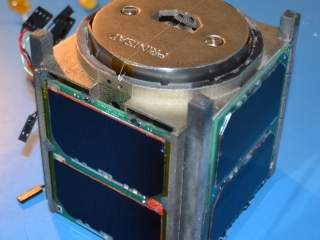Nov 5 2015
Students at Montana State University’s (MSU) Space Science and Engineering Laboratory (SSEL) and space professionals have together developed a tiny satellite using 3D printing technology.
 MSU’s PrintSat is the first to use 3-D printed polymer technology to build the major structural element of a satellite and its mechanisms. Photo courtesy of MSU Space Science and Engineering Laboratory.
MSU’s PrintSat is the first to use 3-D printed polymer technology to build the major structural element of a satellite and its mechanisms. Photo courtesy of MSU Space Science and Engineering Laboratory.
The satellite has been launched into orbit, and the mission will help test the possibilities of using 3D printing technology in building spacecraft.
The PrintSat satellite, as it is called, is a type of CubeSat that weighs less than 1kg, and the cube measures about 4”. The launch will help determine if additive manufacturing or 3D printing technology could be used for making larger spacecraft at lower cost.
The director of MSU’s SSEL, David Klumpar, stated that this launch could have important implications for building future satellites.
Typically, standardized metal is cut into required shapes and sizes for fabricating satellites. For the PrintSat satellite, the researchers used a 3D printer and powdered polymers, and built the satellite using additive manufacturing process. The major structural element and the satellite mechanisms were fabricated using 3-D printed polymer technology. Klumpar stated that NASA had until now flown spacecraft that had only a few parts created using 3D printing.
The PrintSat would conduct an experiment that could help characterize a new solar cell technology, and it would also have a sensor that would be able to measure radiation in space.
“From the data we collect we hope to learn how well this material, and the process used to manufacture the satellite, holds up to the space environment,” Klumpar said. “If the outcome is positive, additive manufacturing could significantly lower the cost and reduce development time of much larger satellites.”
Furthermore, the rocket used for carrying the satellite is the first one to be launched from Hawaii. The launch has taken place at the U.S. Navy’s Pacific Missile Range Facility in Kauai, Hawaii. The Air Force’s Operationally Responsive Space office has managed the launch.
A Super Strypi launcher would carry 13 small spacecraft in total for the launch. Eight CubeSats developed by Ames Research Center would also be part of the mission. Each of these cubesats will carry a science instrument built by MSU, and they would help determine if a network of small satellites could perform better than a single large spacecraft.
Sandia National Laboratories had collaborated with the University of Hawaii to develop the low-cost three-stage Super Strypi launcher vehicle. Klumpar stated that until now MSU had played an important role in nine satellites, including the PrintSat. MSU’s SSEL has been building satellites for 15 years, and approximately 500 students have studied at SSEL. Presently, the MSU program has about 20 students.
“(Our first goal) is getting students --from undergraduate through grad level --intimately involved in the hands-on process of designing, building, testing and operating space hardware,” he said.
“Secondly, our students play a huge role in taking what they have learned in the classroom and applying it to a real-world, true-to-life sophisticated problem. And thirdly, the end-goal is to have our work in the space environment and orbiting around Earth.”
Klumpar stated that the opportunity of working with real satellites helps students enhance their knowledge and learning before they complete graduation.
“That puts our students right at the top of the stack of resumes when they apply for a job,” he said.
Klumpar attended the launch along with Nathan Fite, a MSU graduate student who is presently working at Tyvak Nanosatellite Systems. Fite had worked on the PrintSat when he was a student at MSU.
“We have a lot riding on this launch,” Klumpar said. “We have all of our fingers and toes crossed on this one.”